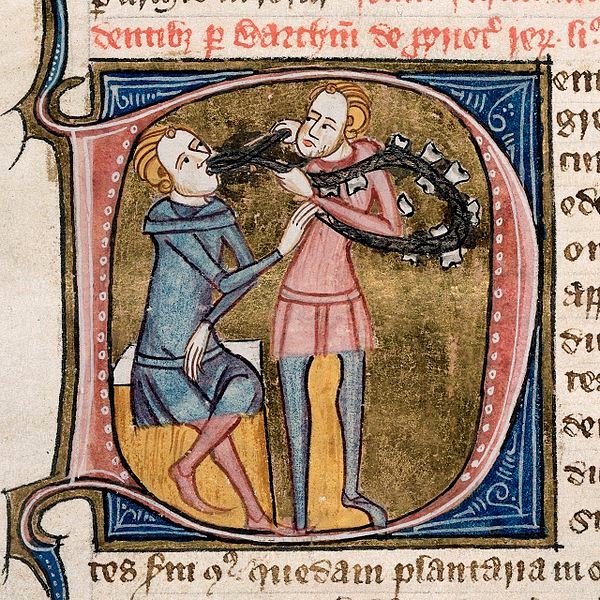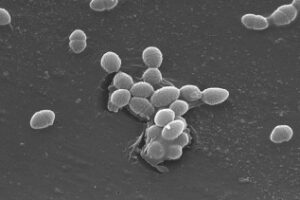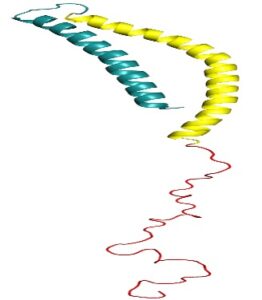
Figure 1: In the image above, one can see a medieval dentist extracting a large tooth from his patient, depicted by the swirl of black flowing across the upper middle of the drawing. In fact, medicine has existed in some form or another for millennia, with each generation using the tools of the times to treat the population.1 As many researchers look to new technology for the future of medicine, some are looking to the past. What can we learn from the medicinal practices of the medieval ages?
For many millennia, people have employed various techniques to increase life span, lessen pain, and treat disease. In 2006, researchers discovered the very first evidence of medicine in the region where Pakistan now is—teeth from a graveyard over 9,000 years old showing signs of dental drilling to cure toothache. Even more surprising was the fact that the team found the dental drills to be “surprisingly effective” at removing decay and cavities, thousands of years before the advent of modern dentistry.1
This type of folk medicine has existed since the beginning of human civilization; modern scientists use the adjective “folk” because such practices are often based around oral tradition, lacking the empirical evidence that we use to justify modern Western medicine.2 This deficit in scientific backing often encourages the conflation of folk medicine with homeopathy, but very little connects the two practices otherwise. Traditional folk medicine differs from homeopathic medicine in both origin and approach: firstly, whereas folk medicine is built upon centuries of cultural knowledge, homeopathy was invented in the 1800s by a German scientist unsatisfied with Western medicine at the time.6 Furthermore, homeopathy is based on the ideas of “like cures like”, “the law of minimum dose”, and self-healing properties of the human body—all properties that have not been found to have any notable effect in human health.5 Even after accounting for these differences from homeopathy, many people still feel that traditional medicine lacks credibility and is even akin to folklore or witchcraft. However, with the rise of research and rigorous inquiry into past medical practices, these types of medicine need not forever be relegated to such a dismissive treatment.
Indeed, with all the resources of the 21st century, researchers now have the ability to test these practices and analyze their scientific foundations. Chinese medicine, a tradition dating back 8,000 years, has already been a frequent subject of such questioning. The findings, though many positive, are not conclusive. However, one should understand that modern Western medicine doesn’t hold up to scrutiny 100% of the time either. For example, a now world-renowned study done by researchers in Houston found that two specific knee surgeries (arthroscopic lavage, arthroscopic debridement), often prescribed to patients with osteoarthritis, were no better than a placebo procedure.5 So, while the results are not necessarily conclusive for Chinese medicinal treatments, this fact doesn’t refute the tradition altogether: numerous NIH studies have shown that acupuncture, for example, can be beneficial in treating ailments from osteoarthritis to asthma. In many ways, some aspects of Chinese medicine are as supported by scientific study as certain procedures in modern medicine. Today, doctors may recommend patients to implement or supplement pre-existing treatment plans with acupuncture, Chinese herbal medicine, or even tai chi for chronic pain, heart disease, mental disorders, or respiratory problems.6
As one can see, research into traditional methods of treatment is extremely important. Centuries of knowledge, passed down through culture and community, have persisted for a reason and it is crucial that researchers not automatically invalidate folk medicine, particularly because such trial-and-error-based practices may actually hold critical findings that would have been hard to discover through applied research. For example, researchers at the University of Warwick recently found that a 1,000-year-old medieval remedy was extremely effective against a range of biofilm pathogens that are notoriously hard to treat with modern antibiotics. This concoction contains a variety of relatively recognizable ingredients: onion, garlic, wine, and bile salts.7
Two factors make this new discovery suitable for medicinal treatment and further inquiry: the mixture did not cause much damage to human cells and it can help fill in the gaps for antimicrobials as doctors try to battle increasingly prevalent antimicrobial resistance (AMR).3 In other words, not only does this thousand-year-old treatment work, it can also perform better than lab-concocted antibiotics in the fight against AMR and superbugs. Interestingly enough, the mixture uses garlic, which has a compound called allicin. Allicin is famous for reducing inflammation, carrying antioxidant benefits, and killing planktonic cultures. However, garlic itself has no activity against biofilms, and to date, no other compound in the mixture has registered, independent activity against biofilms. Therefore, the anti-biofilm activity of the salve only occurs in the presence of all four ingredients—something that would have taken an unspeakable amount of time to stumble upon if we were to try and recreate the mixture from scratch.7
Such findings are surprising and promising. After all, not many people would expect to find notable cures from the past, where there was no scientific testing but a lot of superstition. However, the field of medical anthropology specifically aims to look into the past because it holds tremendous value for the modern world. Research into natural, traditional, and herbal cures are increasingly supplementing our growing knowledge of innovative, Western technology and medicine. From the looks of it, such an approach may just be the ticket for a more holistic, improved understanding of the human body and the world around us.4
References
- Acupuncture. Johns Hopkins Medicine. (2020). Retrieved 4 August 2020, from https://www.hopkinsmedicine.org/health/wellness-and-prevention/acupuncture.
- BBC NEWS | Science/Nature | Stone age man used dentist drill. News.bbc.co.uk. (2020). Retrieved 1 August 2020, from http://news.bbc.co.uk/2/hi/science/nature/4882968.stm.
- Definition of FOLK MEDICINE. Merriam-webster.com. (2020). Retrieved 1 August 2020, from https://www.merriam-webster.com/dictionary/folk%20medicine.
- Furner-Pardoe, J., Anonye, B., Cain, R., Moat, J., Ortori, C., & Lee, C. et al. (2020).Anti-biofilm efficacy of a medieval treatment for bacterial infection requires the combination of multiple ingredients. Scientific Reports. Retrieved 1 August 2020, from https://www.nature.com/articles/s41598-020-69273-8.
- Homeopathy. Nccih.nih.gov. (2020). Retrieved 4 August 2020, from https://www.nccih.nih.gov/health/homeopathy.
- Homeopathy: What It Is, Benefits, Risks, and More. WebMD. (2020). Retrieved 4 August 2020, from https://www.webmd.com/balance/what-is-homeopathy#1.
- Medical Anthropology | Department of Anthropology. Anthropology.stanford.edu. (2020). Retrieved 1 August 2020, from https://anthropology.stanford.edu/research-projects/medical-anthropology.
- Moseley, J., O’Malley, K., Petersen, N., Menke, T., Brody, B., & Kuykendall, D. et al. (2002). A Controlled Trial of Arthroscopic Surgery for Osteoarthritis of the Knee.New England Journal Of Medicine, 347(2), 81-88. https://doi.org/10.1056/nejmoa013259
- nih.gov. (2020). Retrieved 1 August 2020, from https://www.nccih.nih.gov/health/traditional-chinese-medicine-what-you-need-to-know.
- Pan, S., Litscher, G., Gao, S., Zhou, S., Yu, Z., & Chen, H. et al. (2020).Historical Perspective of Traditional Indigenous Medical Practices: The Current Renaissance and Conservation of Herbal Resources. Retrieved 4 August 2020, from.
Related Posts
Your Personality Might Say Less About Your Brain, And More About Your Microbiome
Figure 1: A scanning electron micrograph of Enterococcus faecalis, a bacterium...
Read MoreHow Tele-Mental Health Helps Us During the COVID-19 Pandemic
Figure 1: Telehealth consultation via smartphones can serve as a...
Read MoreA New Method to Track Parkinson’s Disease
Figure 1: 3D structure of alpha-synuclein protein. Mutations in alpha-synuclein...
Read MoreLove Tsai



